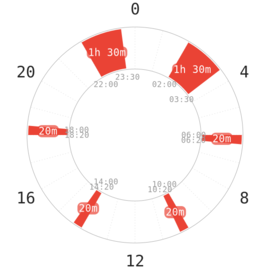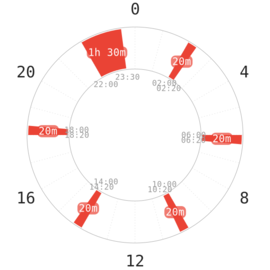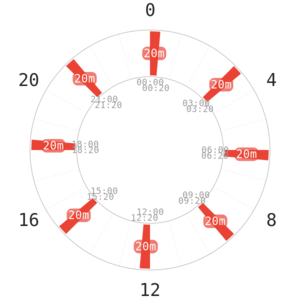Uberman
| Uberman 6 | |
|---|---|
| chart link
Legend
| |
| Total sleep | 2 hours |
| Proposed by | Puredoxyk |
| Difficulty | Extremely difficult |
| Specification | 6 naps equidistantly placed throughout the day |
Uberman is the most widely known form of polyphasic sleep, with its appeal being the large amount of extra time it provides. For this reason, it is also one of the most widely attempted schedules by many first-time polyphasers. However, the adaptation success for this schedule is few and far between, with virtually all attempts at the schedule ending in failure, since it does not meet the minimum sleep need for the majority of people.
Mechanism
Since REM and SWS cannot realistically be cut, all(or at least as much as possible) of them must be accounted for by naps. The extremely low total sleep time means it requires intense sleep compression, possibly reducing the cycle legnths to under 60 minutes. After adapting, falling asleep becomes very quick and the transition to REM or SWS would also be almost immediate, giving nearly negligible amounts of light sleep. This would allow up to about 1h50m of REM and SWS combined. Even so, this is still far below the combined requirements for most people, which means REM and/or SWS have to be cut in order to maintain this schedule, which is considered unhealthy.
History
This schedule is invented and named by Marie Staver (Puredoxyk) and her buddy Psuke Briah in 1999, drawing inspiration from a TIME article about Buckminster Fuller’s Dymaxion sleep. It was first revealed in a post on everything2.com in 2000.
Puredoxyk stayed on the schedule for 6 months in 2000 and she was not able to re-adapt to it later.
Steve Pavlina adapted to the schedule in 2005, and stayed on it for 5 months, and has not done it again ever since.
Difficulty
Both Steve Pavlina’s blogs and Puredoxyk’s book Ubersleep greatly understated the schedule’s difficulty. Puredoxyk adapted to the schedule in times of extreme stress at university, and was unable to adapt to it again afterwards. Nevertheless, people tend to overestimate their chances of succeeding. There has been no detailed accounts of someone adapting to the schedule in more recent times. You may see many logs of people attempting this schedule, but most of them ends in just a few days, presumably because the author overslept and gave up. Those failures are often used to discredit polyphasic sleep altogether, without ever considering more reasonable schedules.
Human supervision
It is important to realise that willpower alone is not enough for adapting to this schedule. With SWS deprivation, willpower simply will not help you. People have reported unconsciously disabling or ignoring electronic devices and performing other actions necessary to go back to sleep, with no recall whatsoever afterwards. People have slept through noise-based alarms, flashing lights, loud fans, and repeated maximum-voltage shocks from a Pavlok. It is therefore very useful, if not necessary, to have constant human supervision to make sure you are awake when you are supposed to be. To our best knowledge, no one has ever adapted to this schedule without the help of another human. Puredoxyk was woken up by Psuke and youtuber aeia was woken up by her twin sister during their uberman adaptation. Without the help of other people, it is virtually impossible that you would ever adapt to this schedule.
Adaptation
Adapting to uberman is extremely difficult. While some people may claim that there is an easier method, that is simply not the case. Any methods of adapting to this schedule involves prolonged, intense sleep deprivation which is necessary to produce the level of sleep compression required.
Without previous napping experience, naps will mostly contain light sleep or traces of SWS. As the REM need is not being fulfilled, REM pressure quickly builds up to high levels, causing a REM rebound. This usually happens around day 3-5. <This will appear to suddenly alleviate the sleep deprivation, making people prone to overconfidence about the adaptation.> After this, naps mostly contain REM, and SWS pressure starts to build up. SWS rebound usually occurs on day 7-8 and it is the hardest part of the adaptation where most people oversleep and fail their schedules. After avoiding this first crash, subsequent crashes once every 2-3 days also needs to be avoided. REM and SWS pressure gradually reaches an equilibrium and the schedule is finally stablised. This can take weeks and some may need up to 6 weeks on the schedule.
Delaying the SWS rebound
It is possible to delay the SWS rebound by a few days by adding extra naps in the night for extra SWS gain during the first days of adaptation. Steve Pavlina used this method to delay his SWS rebound until around day 12. It is not generally a good idea though, since the rebound will eventually happen and doing this just drags out the adaptation process by a few days and overcoming the SWS rebound is essential to Uberman adaptation.
Gradual adaptation via rhythmic preservation
These are possible transition schedules to Uberman with sleeps scheduled to start at the same time as the goal Uberman schedule. It might train the body rhythm to align the waves of tiredness with Uberman naps. This could reduce the transition difficulty somewhat. Still, intense compression and repartition will be required at the each transition, especially the final jump to Uberman. With two transitions, the adaptation is stretched out to several months and the overall difficulty is only slightly reduced. Overall, this may not be worth the extra time required.
Naptation/Exaptation
This methods involves staying awake for 1-2 days to quickly increase sleep pressure and/or start with naps every 2 hours instead of 4 to quickly acquire the ability to gain REM during naps.
Variants
Extra naps
Having one or two extra naps might make Uberman more sustainable for people since 2h is far below the minimum requirements of an average person, and consequently lower adaptation difficulty. However, these variants even less realistic socially since 3h5m and 2h40m wake blocks are simply too short for doing anything. No one is known to have adapted to these variants of Uberman.
Denser nightime naps
In this variation of Uberman more naps are placed during the night since sleep pressure is generally higher during nighttime and it would also be easier to schedule one’s life around longer daytime gaps. However, it is very difficult to stay awake for long periods of time on Uberman and this is likely even harder than regular Uberman. No one has been known to have adapted to this, either.




